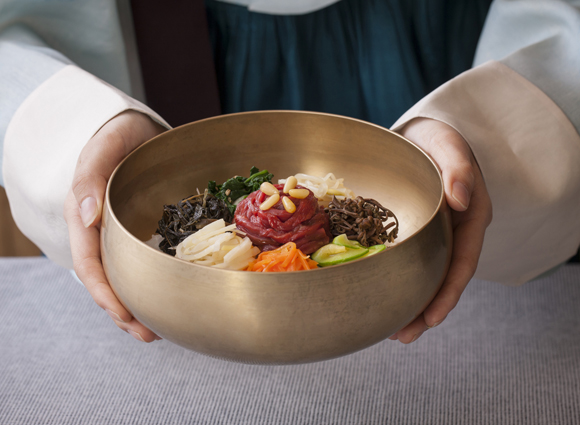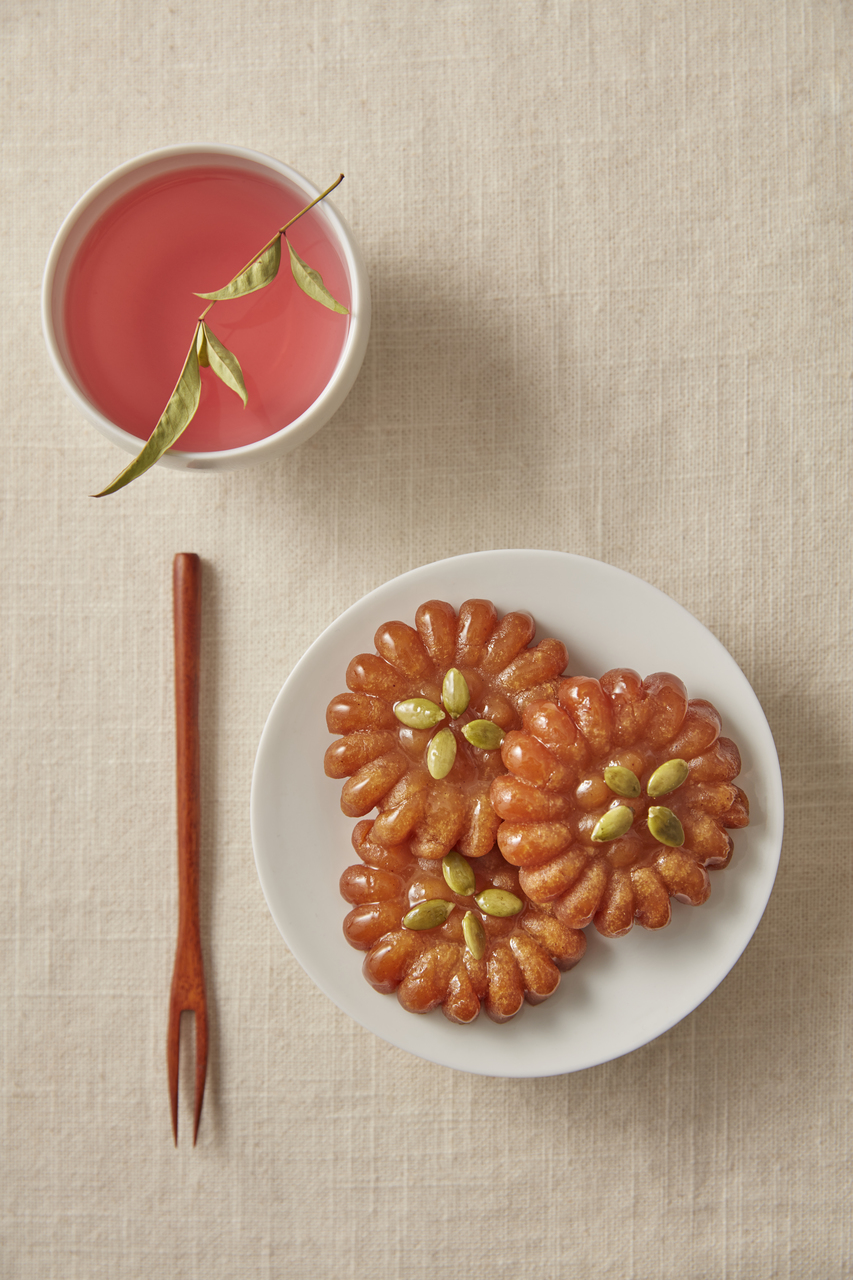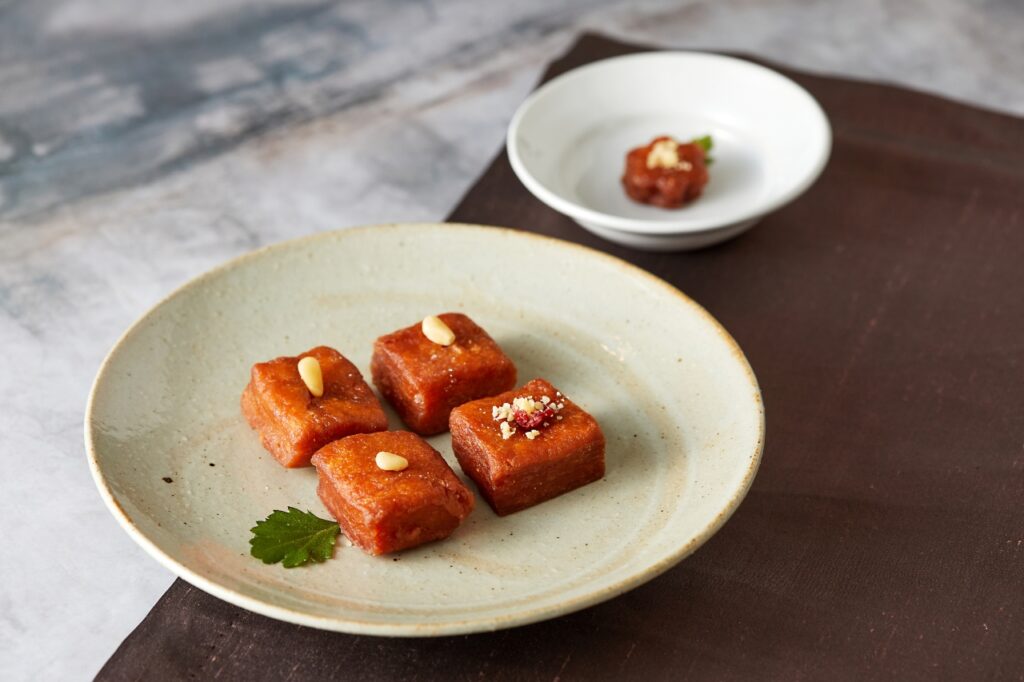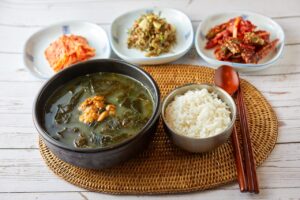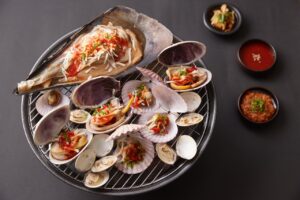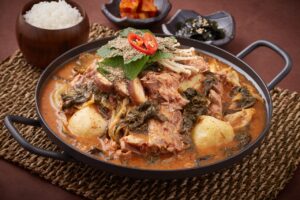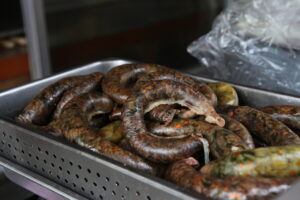-
Makgeolli, the Harmony of Korean Food and Liquor – 2023
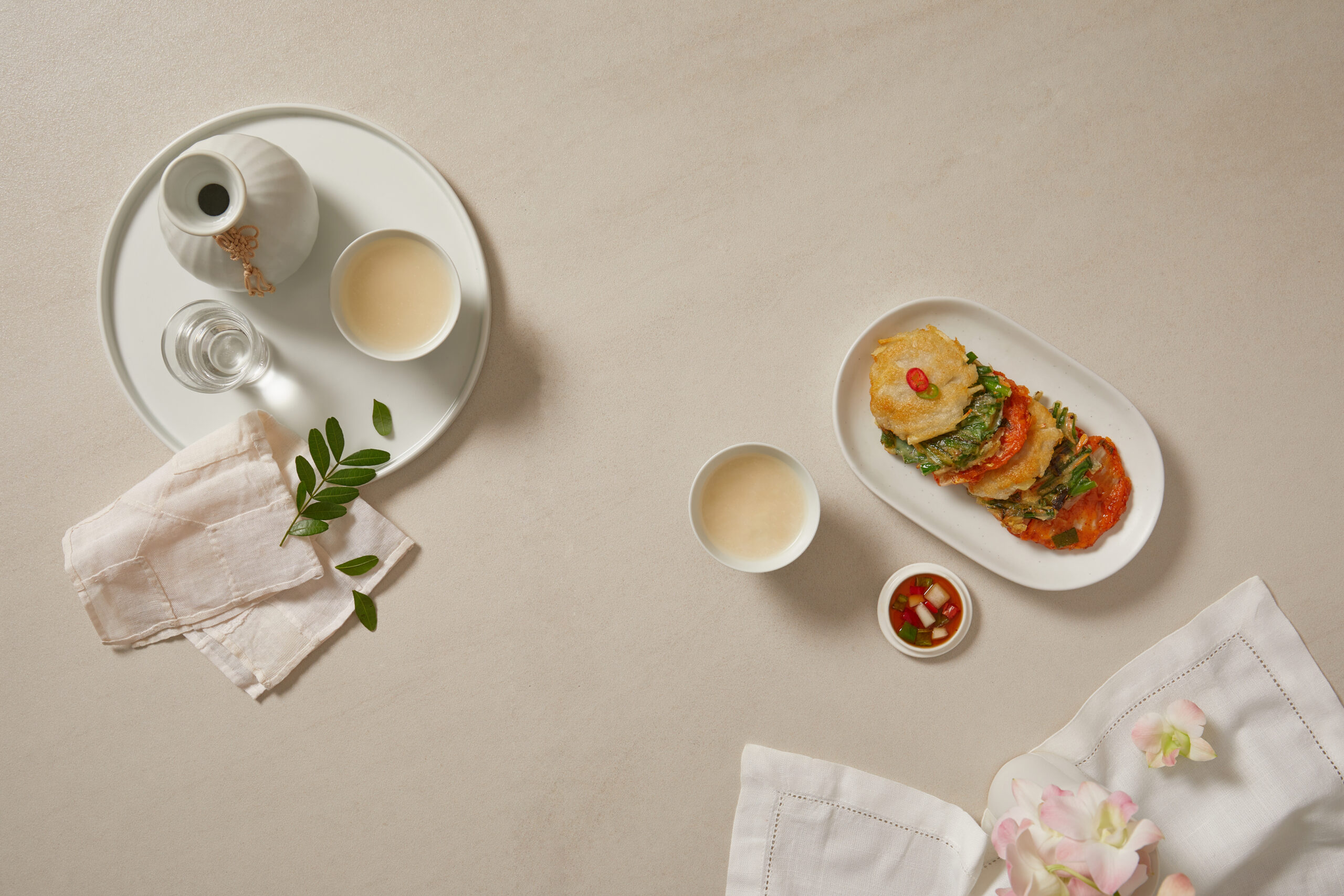
Makgeolli is traditional Korean Liquor
Makgeolli (막걸리) is a traditional Korean alcoholic beverage that has been enjoyed for centuries. It’s often referred to as “rice wine,” although it’s more accurately categorized as a type of fermented rice or grain-based alcohol. Makgeolli is known for its slightly sweet and tangy flavor, cloudy appearance, and relatively low alcohol content compared to other alcoholic beverages.
Here’s a closer look at Makgeolli:
Ingredients and Fermentation: Makgeolli is primarily made from rice, although other grains like wheat or barley can also be used. The grains are first cooked and then mixed with nuruk, a fermentation starter that contains enzymes and yeasts. The mixture is left to ferment, which results in the conversion of starches into sugars and the production of alcohol.
Flavor and Appearance: Makgeolli has a distinctive milky or cloudy appearance due to the presence of rice particles and yeast sediment. The flavor profile of Makgeolli is often described as mildly sweet, slightly tangy, and sometimes effervescent. The taste can vary depending on factors like the type of rice used, the fermentation process, and any additional flavorings or additives.
Alcohol Content: Makgeolli typically has an alcohol content ranging from about 6% to 8%, making it relatively mild compared to other alcoholic beverages like soju or beer.
Serving and Consumption: Makgeolli is usually served chilled and stirred before drinking to evenly distribute the sediment. It’s traditionally poured from a large bowl or jar into small individual cups. In Korean culture, Makgeolli is often enjoyed with a variety of savory and spicy dishes, as its slightly sweet and tangy profile pairs well with Korean cuisine.
Variations and Additions: Modern variations of Makgeolli may include additional ingredients for flavor, such as fruits, herbs, or honey. These variations can create a wide range of flavors and experiences beyond the traditional base Makgeolli.
Cultural Significance: Makgeolli has a cultural significance in Korea and is associated with social gatherings, celebrations, and traditional rituals. It’s also part of the country’s intangible cultural heritage.
Makgeolli’s popularity has grown beyond Korea’s borders, and it’s enjoyed by both locals and foreigners. If you have the chance to try it, Makgeolli offers a unique taste of Korean culinary and cultural heritage.
How to make Makgeolli?
Making Makgeolli at home involves a fermentation process that converts rice or other grains into a slightly sweet and tangy alcoholic beverage. Here’s a simplified recipe for making Makgeolli:
Ingredients:
- 2 cups of short-grain rice (or glutinous rice)
- 4 cups of water (for cooking rice)
- 1/2 cup of nuruk (Korean fermentation starter)
- 1/2 cup of water (for mixing with nuruk)
- Sugar (optional, for adjusting sweetness)
- Clean and sanitized fermentation vessel (glass jar or ceramic crock)
- Cheesecloth or clean cloth for covering
Instructions:
- Prepare the Rice:
- Rinse the rice under cold water until the water runs clear.
- Cook the rice with 4 cups of water until it’s fully cooked and slightly sticky.
- Cool the Rice:
- Let the cooked rice cool down to room temperature. It should be warm but not hot.
- Mix Nuruk and Water:
- In a separate bowl, mix the nuruk with 1/2 cup of water to create a paste. Nuruk contains enzymes and yeasts that initiate fermentation.
- Combine Rice and Nuruk Mixture:
- In a clean and sanitized fermentation vessel, combine the cooled rice and the nuruk mixture. Mix well to evenly distribute the nuruk.
- Cover and Ferment:
- Cover the vessel with cheesecloth or a clean cloth, securing it with a rubber band or string.
- Place the vessel in a warm, dark, and relatively undisturbed location to ferment. The ideal temperature is around 20-25°C (68-77°F).
- Fermentation:
- Fermentation will occur over the next few days. During this time, the mixture will become slightly bubbly and cloudy as the yeast activates.
- Strain and Store:
- After about 3-5 days, strain the liquid through a fine mesh strainer or cheesecloth to remove the rice solids. This will result in the cloudy Makgeolli liquid.
- Adjust Sweetness (Optional):
- Taste the Makgeolli and if desired, add sugar to adjust the sweetness to your preference. Stir until the sugar is dissolved.
- Bottle and Refrigerate:
- Transfer the Makgeolli to clean, airtight bottles or jars. Seal the containers and refrigerate them to slow down fermentation and maintain freshness.
- Serve and Enjoy:
- Once chilled, your homemade Makgeolli is ready to be served. Remember to gently stir before pouring to mix any sediment that settles.
Note that making Makgeolli at home involves a fermentation process that may require careful attention and sanitation. While this recipe provides a general guideline, variations in temperature, ingredients, and fermentation time can lead to different outcomes. If you’re new to fermentation, you might want to start with a small batch and familiarize yourself with the process before attempting larger batches.
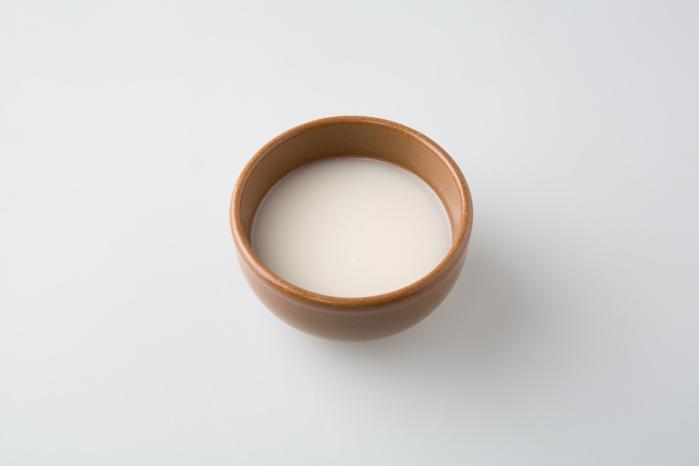
Makgeolli in the bowl (www.k-foodtrade.or.kr) Which Food does Makgeolli go well with?
Makgeolli, with its slightly sweet and tangy flavor profile, pairs well with a variety of Korean dishes. Its versatility makes it a popular choice for enjoying with different types of foods. Here are some types of dishes that Makgeolli goes well with:
- Jeon (전): Jeon refers to a variety of Korean savory pancakes. These can be made with ingredients like vegetables, seafood, or kimchi. The crispy texture and savory flavors of jeon complement the slightly sweet and tangy notes of Makgeolli.
- Pajeon (파전): Pajeon specifically refers to green onion pancakes. The combination of green onions and Makgeolli is a classic pairing, as the refreshing flavor of green onions contrasts nicely with the drink.
- Tteokbokki (떡볶이): Tteokbokki, or spicy rice cakes, features chewy rice cakes in a spicy sauce. The mild sweetness of Makgeolli can help balance out the heat and spiciness of tteokbokki.
- Twigim (튀김): Twigim is a term for various Korean fried snacks, such as fried vegetables, fish cakes, or even tempura-style dishes. The crispy texture of fried foods contrasts well with the drink’s smoothness.
- Mandu (만두): Mandu are Korean dumplings, often filled with a mixture of meat and vegetables. The savory flavors of mandu are complemented by the slightly sweet and tangy Makgeolli.
- Jokbal (족발): Jokbal is a Korean dish consisting of pig’s trotters that are cooked until tender. The rich and savory flavors of jokbal can be nicely balanced by the drink’s acidity.
- Anju (안주): Anju are Korean snacks or appetizers often enjoyed with alcoholic beverages. A wide range of anju, including dried squid, peanuts, and other savory bites, can be paired with Makgeolli.
- Bindaetteok (빈대떡): Bindaetteok, or mung bean pancakes, have a crispy exterior and soft interior. The earthy flavors of bindaetteok complement the Makgeolli’s taste.
- Kimchi (김치): Kimchi, a staple in Korean cuisine, can be enjoyed alongside Makgeolli. The fermented and spicy flavors of kimchi harmonize well with the drink’s tanginess.
- Banchan (반찬): Banchan are various side dishes served in Korean cuisine. Makgeolli can be enjoyed with a selection of banchan, providing a range of flavors and textures to explore.
Remember that personal preferences vary, so feel free to experiment and discover your own favorite pairings. The goal is to find a balance that enhances your enjoyment of both the food and the drink.
Mariage of Traditional Liguor and Korean Jeon (from Hansikmagazine.org)
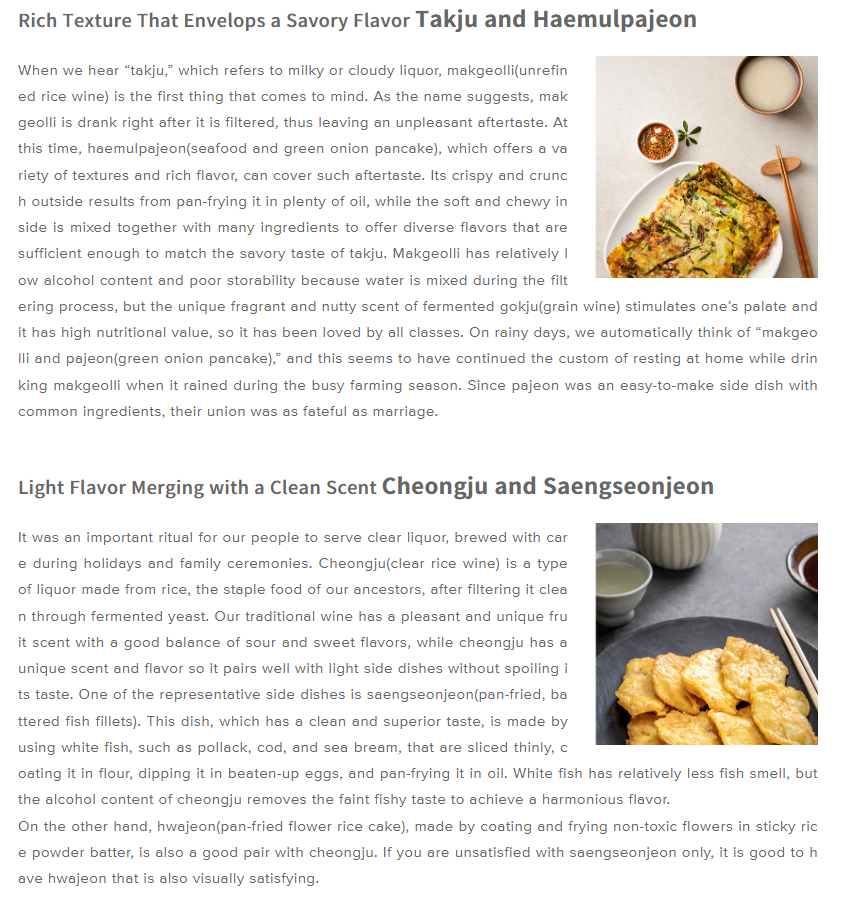
한식진흥원 : Mariage of Traditional Liquor and Korean Jeon (hansikmagazine.org) 
-
Vegetarian Food in Temple Stay in Korea 2023
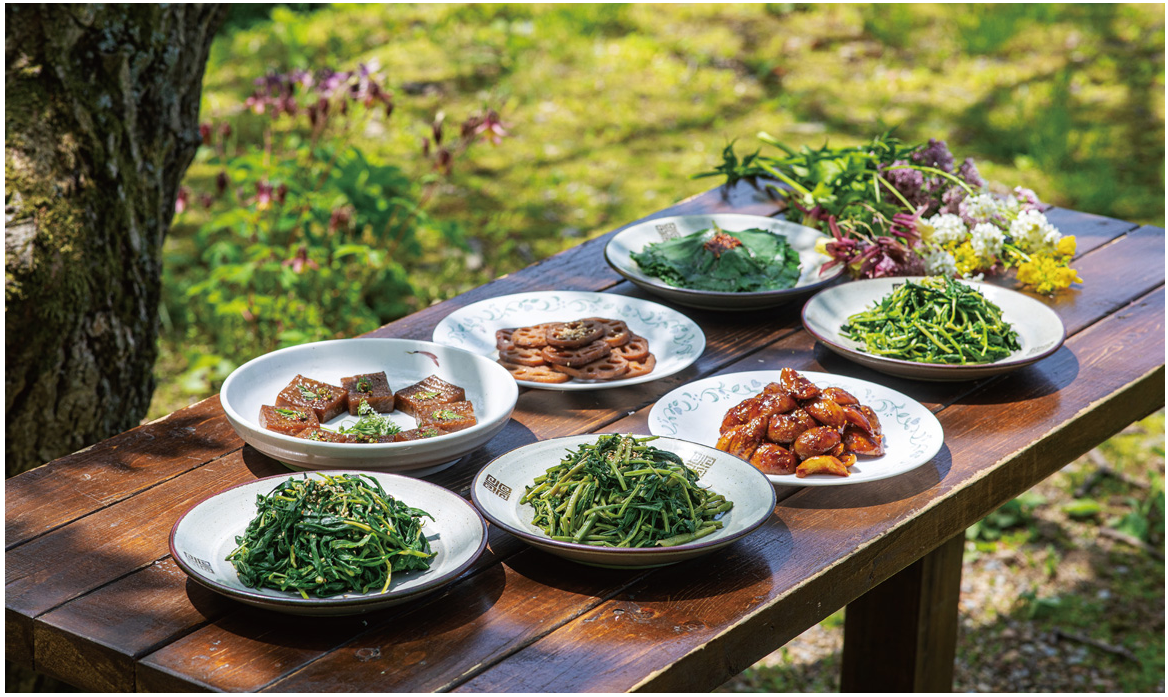
Food During Temple Stay
Korean food is known to be suitable for vegetarians. Among them, temple food is the most vegetarian food. Let’s look at Korean temple food and templestay.
Buddhist Temples are places of worship, meditation, and spiritual practice for followers of Buddhism. They often serve as centers for learning, meditation retreats, and community activities. Buddhist temples can vary in size and style, but they typically have a serene and contemplative atmosphere. In South Korea, temples play a significant role in the country’s cultural and religious landscape.
Temple Stay Programs: A “temple stay” program allows individuals, both locals and tourists, to experience the daily life of Buddhist monks and nuns by staying at a temple for a short period of time. These programs offer participants a chance to learn about Buddhist practices, engage in meditation, and gain insights into the temple’s routines. Temple stay programs are a way to disconnect from the fast-paced world and immerse oneself in a peaceful and mindful environment.
Food during Temple Stay: Food is an integral part of the temple stay experience. Participants are offered simple and vegetarian meals that align with Buddhist dietary principles. The meals are typically prepared with mindfulness and in accordance with the temple’s practices. While specifics can vary from temple to temple, here’s what you might expect:
- Vegetarian Cuisine: Most temple stays offer strictly vegetarian meals, which exclude meat and animal products. The meals are often simple, nutritious, and thoughtfully prepared.
- Mindful Eating: Meals are consumed in silence or in a quiet environment. This encourages participants to eat mindfully and appreciate the flavors and textures of each dish.
- Set Meal Times: Meals are served at specific times, often in the morning and early afternoon. Participants are expected to adhere to the temple’s schedule.
- Community Dining: Participants usually dine together in a communal setting, fostering a sense of togetherness and shared experience.
- Traditional Dishes: Temple stay meals might include rice, various vegetable dishes, tofu-based dishes, soups, and more. The focus is on simple, wholesome, and balanced nutrition.
- Cultural Experience: Sharing meals with monks and fellow participants is a cultural experience that offers insights into temple life, Buddhism, and Korean traditions.
- Respectful Dining: Participants are expected to eat mindfully, avoid wasting food, and follow any eating customs or guidelines set by the temple.
Participating in a temple stay program provides an opportunity not only to learn about Buddhism and temple life but also to embrace a lifestyle of mindfulness and simplicity. The experience of sharing vegetarian meals in a serene temple environment can have a profound impact on one’s perspective and well-being.

Image from : https://webzine.templestay.com (템플스테이) Vegetarian Food in Temple Stay
During a temple stay program in Korea, the food served is typically vegetarian and reflects the principles of Buddhist dietary practices. The meals are simple, nutritious, and often prepared with mindfulness. While the exact menu can vary from temple to temple, here are some common types of food that you might find during a temple stay:
- Rice (Bap, 밥): A staple of Korean cuisine, rice is a fundamental part of temple stay meals.
- Various Vegetable Dishes: A variety of vegetable dishes are served, showcasing different flavors, textures, and cooking methods. This can include sautéed, steamed, and stir-fried vegetables.
- Tofu Dishes: Tofu is a protein-rich ingredient and often prepared in different ways, such as grilled, braised, or in soups.
- Namul (Seasoned Vegetables, 나물): Namul dishes are made by blanching or sautéing various types of wild or cultivated greens, and they are a common component of Korean temple cuisine.
- Soups (Guk, 국 or Jjigae, 찌개): Simple vegetable-based soups are served, providing warmth and nourishment.
- Porridge (Juk, 죽): Rice porridge, made by cooking rice in water or broth until it becomes creamy, is often served as a comforting dish.
- Pickled Vegetables (Jangajji, 장아찌): Pickled vegetables add flavor and variety to the meals.
- Fruits: Fresh fruits might be served as a refreshing and naturally sweet element.
- Grains and Legumes: Whole grains and legumes like beans and lentils are sometimes included for added nutrition.
- Tea: Different types of herbal teas, often made from ingredients like ginger, jujube, or omija (Schisandra berries), can be served for refreshment.
- Sesame Oil and Seeds: These are commonly used for flavoring and nutrition.
It’s important to note that the emphasis during a temple stay is on mindfulness, gratitude, and simplicity. Meals are often eaten in silence or with minimal conversation, allowing participants to fully engage with the act of eating. Sharing in the temple’s meals can offer a unique and meaningful experience, fostering a sense of connection to the principles of Buddhism and promoting a sense of well-being.
Templestay Information Center in Seoul
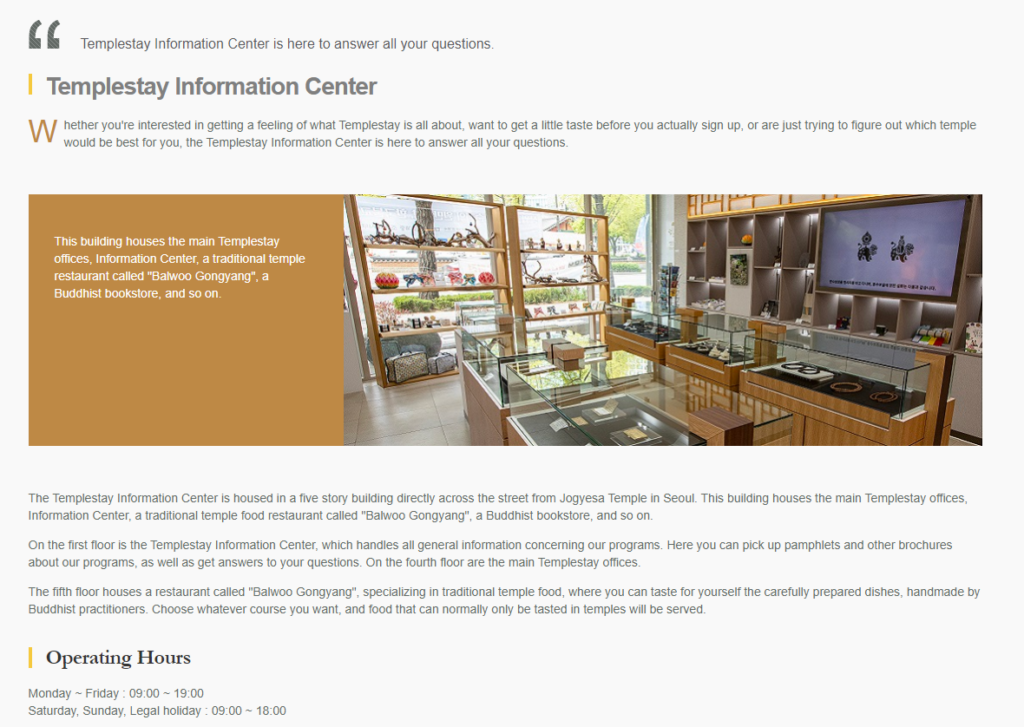

Website for Templestay in Korea

Templestay | Finding your ‘True-self’ 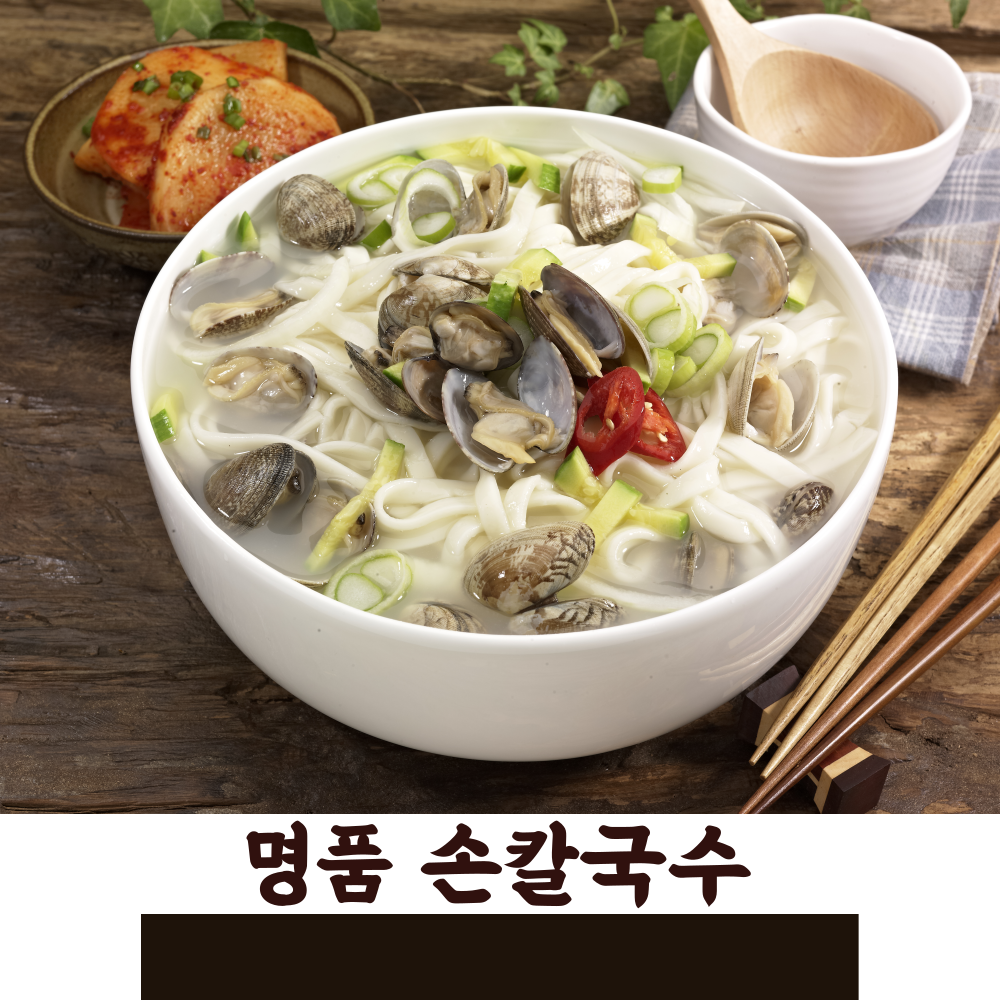
About See Food Kalguksu -
Jeju-Ireland(제주도) Black pork BBQ(제주도 흑돼지 구이) 2023
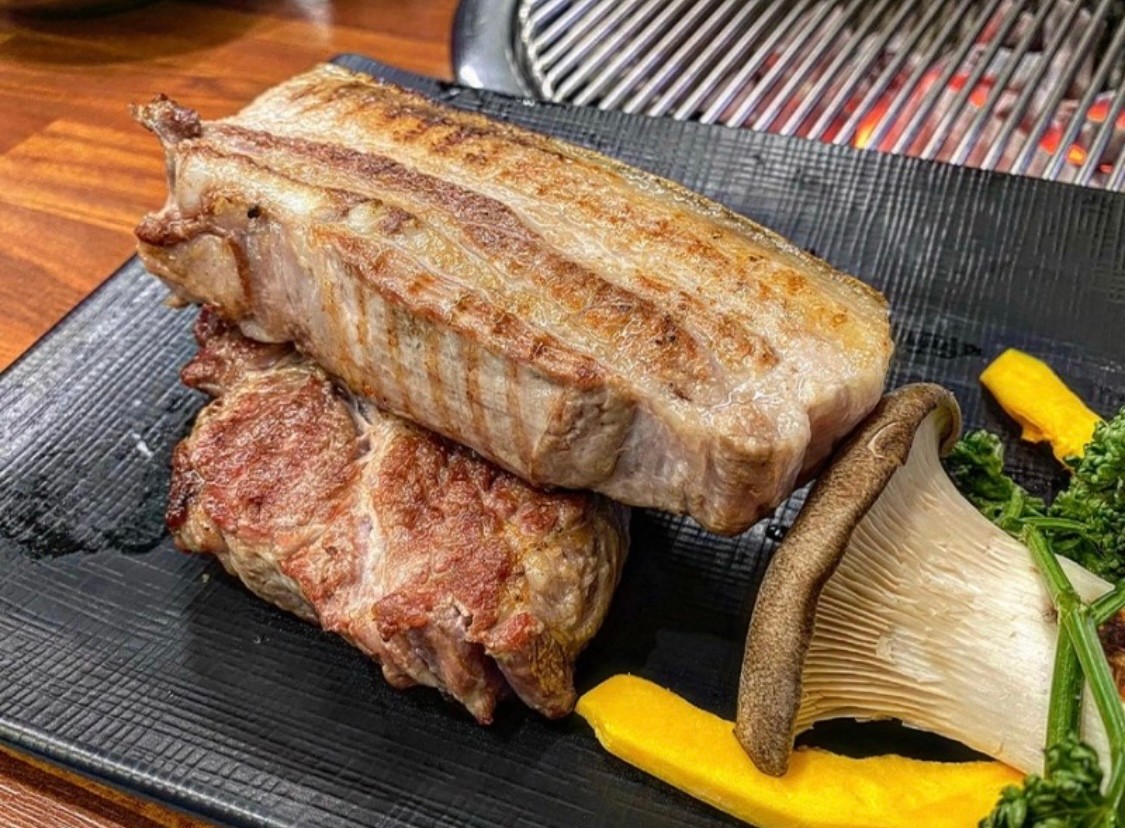
Jeju Black Pork (제주 흑돼지) is a special breed of pig native to Jeju Island, a volcanic island located off the southern coast of South Korea. The meat from these pigs is highly prized for its unique flavor, tenderness, and marbling, making it a sought-after delicacy in Korean cuisine. The name “Jeju Black Pork” comes from the dark color of the pig’s skin.
Here are some key characteristics of Jeju Black Pork:
- Origin and Breed: Jeju Black Pork is a breed that has been developed on Jeju Island over many years. The pigs are known for their adaptation to the island’s environment, which includes volcanic soil and clean natural surroundings.
- Diet and Environment: The pigs are raised in a natural and stress-free environment. They graze on Jeju’s abundant vegetation and are often given a special diet that contributes to the quality of their meat.
- Flavor and Marbling: The meat of Jeju Black Pork is praised for its rich, deep flavor and tender texture. It has a good amount of intramuscular fat, or marbling, which contributes to its succulence and flavor profile.
- Health Benefits: Some claim that Jeju Black Pork is healthier compared to regular pork due to its higher unsaturated fatty acid content and lower cholesterol levels. However, it’s important to note that this perception might be subjective and can vary.
- Culinary Uses: The meat is used in a variety of Korean dishes, including grilling, BBQ, stews, and hot pots. It’s often featured in Jeju-style BBQ restaurants where customers can grill the meat at their table.
- Cultural Significance: Jeju Black Pork is not only a culinary delight but also has cultural significance on Jeju Island. It has become a symbol of the island’s local flavors and is a must-try for tourists visiting the area.
If you visit Jeju Island, trying dishes made with Jeju Black Pork, especially in a BBQ setting, is a recommended culinary experience. It offers a chance to savor the island’s unique flavors and the distinct taste of this locally bred pig.
Kinds of Black pork dich
- Jeju Black Pork BBQ (흑돼지 바비큐): One of the most iconic ways to enjoy Jeju Black Pork is through BBQ. Thinly sliced pork is marinated or seasoned and then grilled at the table. The interactive dining experience allows you to cook the meat to your preference and wrap it in lettuce leaves with various condiments.
- Jeju Black Pork Hot Pot (흑돼지 해장국): This is a hearty and flavorful hot pot dish that features Jeju Black Pork along with vegetables and other ingredients. It’s often enjoyed as a warming and comforting meal, especially during colder months.
- Jeju Black Pork Noodles (흑돼지 국수): Jeju Black Pork is sometimes incorporated into noodle dishes. The pork can be added to various noodle soups or stir-fried noodle dishes, adding its distinctive flavor to the dish.
- Jeju Black Pork Rice Bowl (흑돼지 도시락): Jeju Black Pork might also be served as a topping for rice bowls, creating a flavorful and satisfying meal.
- Jeju Black Pork Dumplings (흑돼지 만두): Some restaurants might offer dumplings filled with Jeju Black Pork as a delicious appetizer or side dish.
- Jeju Black Pork Sausages (흑돼지 소시지): Sausages made from Jeju Black Pork are another creative way to enjoy the meat. They might be seasoned with local flavors and herbs.
- Jeju Black Pork Kimchi Stew (흑돼지 김치찌개): Combining the rich flavors of Jeju Black Pork with the tangy and spicy notes of kimchi, this stew is a fusion of flavors that’s quite popular.
- Jeju Black Pork Street Food: In addition to restaurants, you might find street food stalls that offer Jeju Black Pork skewers or other small bites for a quick and tasty snack.
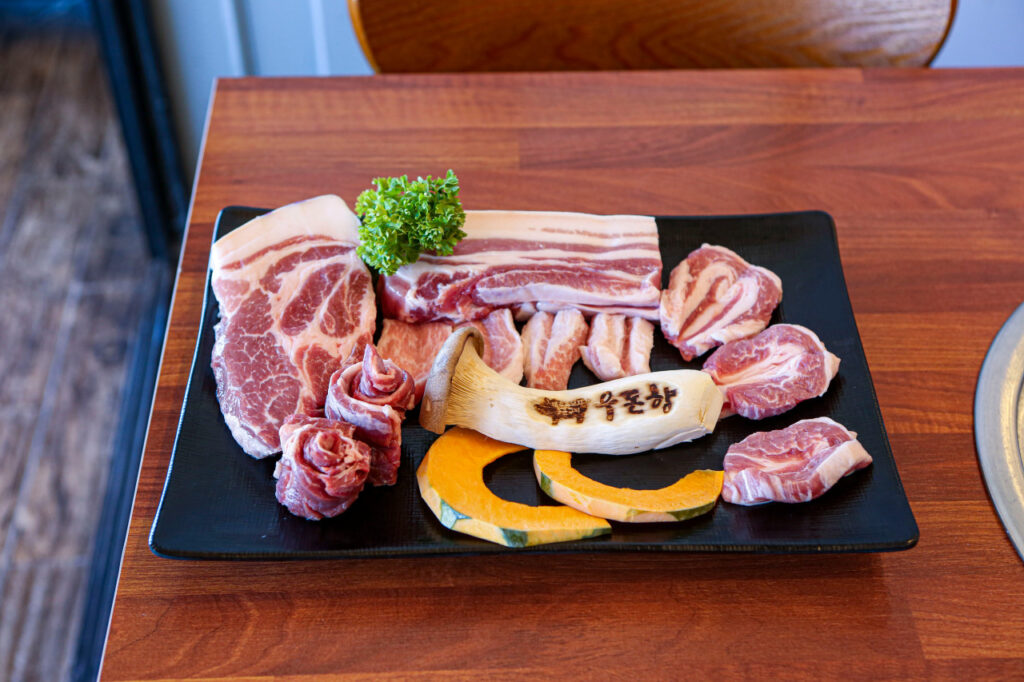
함덕흑돼지우돈향
주소 : 제주 제주시 조천읍 조함해안로 530 2층 우돈향
JogaeGui, The Most Famous Shellfish Dishes Nov. 2023 – Korean Food Nearby
-
Galbijjim is Special Holiday, Special Food Aug 2023.
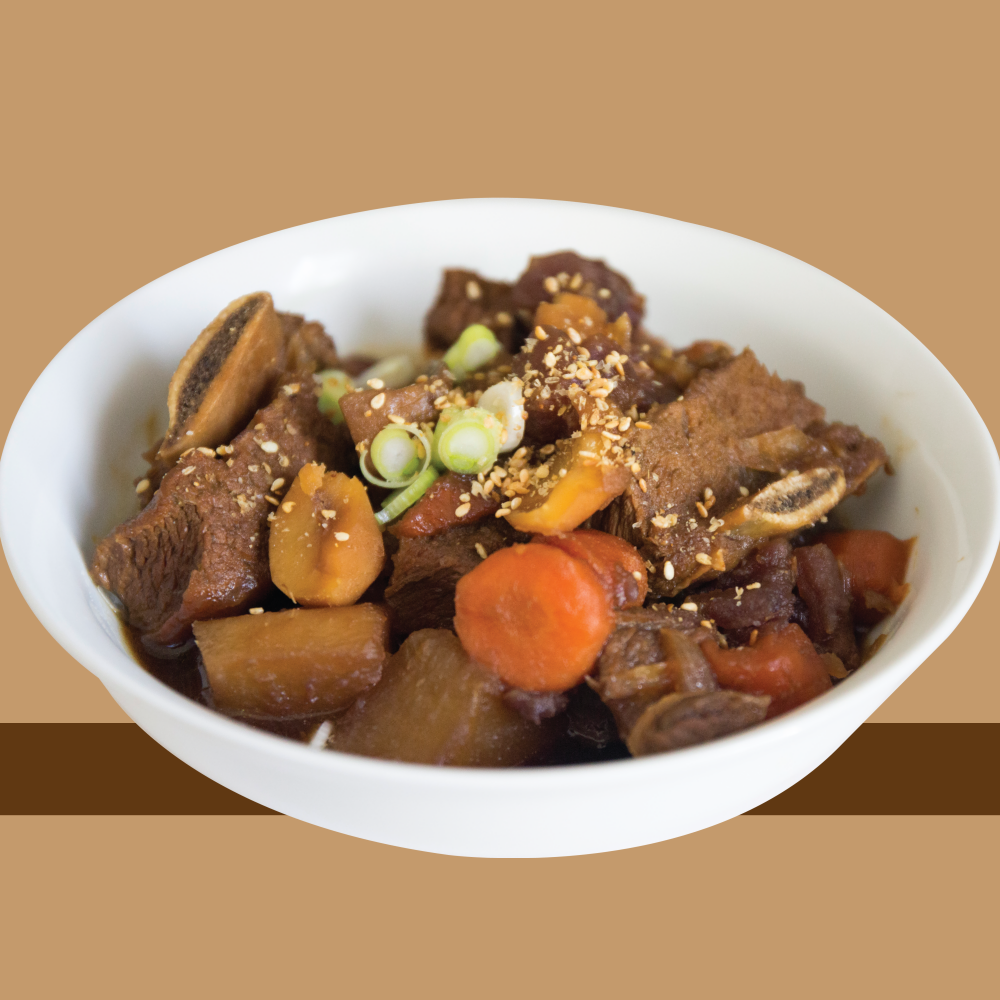
Special Day with GalbiJjim
Galbijjim is often considered a special dish associated with holidays, celebrations, and important occasions in Korea. While it can certainly be enjoyed year-round, it is commonly featured during festive times and gatherings due to its flavorful and indulgent nature. Here are a few reasons why Galbi Jjim is often considered a holiday food:
- Labor-Intensive Preparation: GalbiJjim requires marinating the beef, preparing the vegetables, and slow-cooking the dish for several hours. Because of its time-consuming preparation, it’s often reserved for occasions when families or groups come together and have more time to dedicate to cooking.
- High-Quality Ingredients: GalbiJjim is traditionally made using high-quality beef short ribs and a variety of vegetables. The use of quality ingredients makes it a special treat that’s often enjoyed during celebrations.
- Flavor and Presentation: The rich and savory flavors of GalbiJjim, along with its beautifully braised short ribs and vibrant vegetables, make it visually appealing and a delightful centerpiece for special meals.
- Symbolism of Sharing: Korean holidays and gatherings emphasize the importance of sharing and togetherness. GalbiJjim, with its large portion size and communal serving style, is well-suited for these occasions.
- Tradition and Nostalgia: GalbiJjim is a dish with cultural significance, and many people associate it with fond memories of family gatherings, special occasions, and the warmth of home.
While GalbiJjim is often enjoyed during holidays such as Lunar New Year (Seollal) and Korean Thanksgiving (Chuseok), it’s not limited to these times. Some restaurants specialize in Galbi Jjim and offer it year-round, allowing people to enjoy this delicious dish whenever they like.
Cooking Method
GalbiJjim (갈비찜) is a traditional Korean dish that consists of braised short ribs, often referred to as beef short rib stew or braised beef ribs. It’s a hearty and flavorful dish that features tender and succulent pieces of marinated beef short ribs, slow-cooked with various vegetables and a rich, savory sauce.
The dish is often associated with special occasions, celebrations, and family gatherings due to its labor-intensive preparation and the use of high-quality ingredients. Galbi Jjim is known for its complex flavors and tender texture, making it a favorite among those who enjoy Korean cuisine.
Here’s a general overview of how Galbi Jjim is prepared:
Ingredients:
- Beef short ribs (galbi)
- Vegetables (such as carrots, potatoes, onions, and chestnuts)
- Korean radish (mu) or daikon radish
- Garlic cloves
- Ginger
- Soy sauce
- Sugar
- Mirin (rice wine)
- Sesame oil
- Sesame seeds
- Optional: dried jujubes (Korean red dates), ginkgo nuts, pine nuts
Instructions:
- Marinate the Beef:
- Marinate the beef short ribs in a mixture of soy sauce, sugar, minced garlic, minced ginger, and sesame oil for a few hours or overnight. This step imparts flavor and tenderness to the meat.
- Prepare the Vegetables:
- Peel and cut the Korean radish or daikon radish into chunks.
- Peel and cut the other vegetables into bite-sized pieces.
- Braise the Ingredients:
- In a large pot or braising pan, layer the marinated beef, vegetables, and optional ingredients like dried jujubes, ginkgo nuts, or pine nuts.
- Add water, soy sauce, mirin, and sugar to the pot, creating a flavorful braising liquid.
- Slow Cooking:
- Cover the pot and bring the liquid to a boil. Then, reduce the heat to a simmer and cook the dish for a couple of hours. The slow cooking process allows the meat to become tender and absorb the flavors of the sauce.
- Serve:
- Once the beef is tender and the vegetables are cooked, the Galbi Jjim is ready to be served.
- Garnish the dish with sesame seeds and chopped green onions.
Kinds of Galbijjim
- Beef Galbi Jjim: This is the most common type of Galbi Jjim and is made with beef short ribs. The ribs are marinated and braised in a rich and savory sauce until they become tender and flavorful. Vegetables like carrots, potatoes, onions, and mushrooms are often added to the braising liquid to enhance the taste.
- Pork Galbi Jjim: While beef is more common, pork Galbi Jjim is also popular. Pork ribs are marinated and braised in a similar manner to beef Galbi Jjim. The sauce and seasonings might be adjusted slightly to complement the pork.
- Seafood Galbi Jjim: This variation includes seafood like shrimp, squid, and mussels along with the meat. The seafood is added to the braise to infuse its flavors into the dish.
- Spicy Galbi Jjim: Some versions of Galbi Jjim include a spicy element, often using Korean red pepper paste (gochujang) or red pepper flakes. This adds a bit of heat and depth to the dish’s flavor profile.
- Chestnut Galbi Jjim: Chestnuts are sometimes added to the braising liquid, providing a unique texture and a touch of sweetness to the dish.
- Mushroom Galbi Jjim: If you’re a fan of mushrooms, you might find versions of Galbi Jjim that heavily feature various types of mushrooms in the dish.
- Galbitang: This is a soup version of Galbi Jjim. The short ribs are simmered in a clear broth along with vegetables and often served as a soup rather than a stew.

GalbiJjim in Korean Food Best Galbijjim in Seoul
Place name : Gangnam Myeonok
Address : 34, Nonhyeon-ro 152-gil, Gangnam-gu, Seoul 06026, South Korea
-
Gimbap: 9 Reasons Koreans Like It
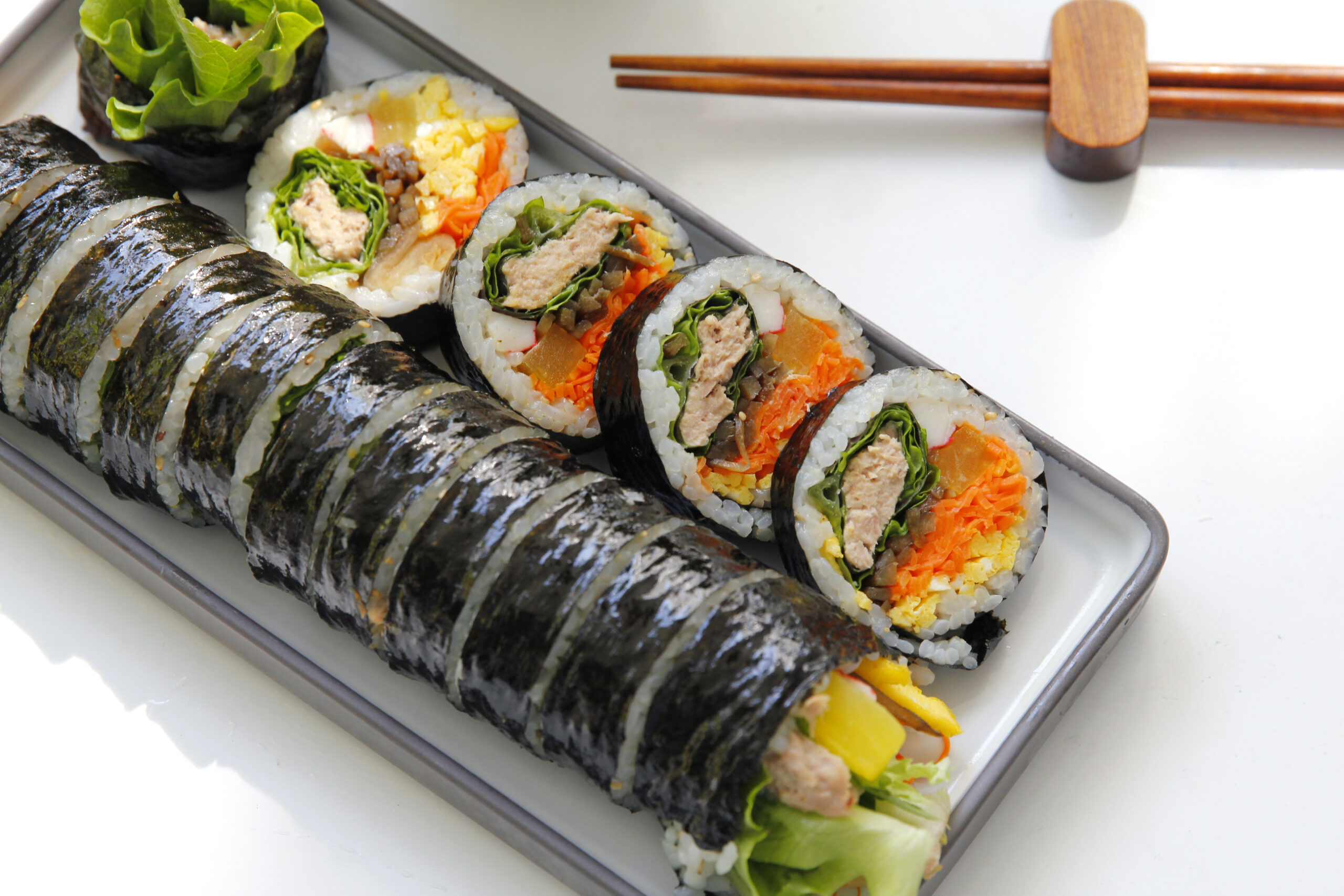
Koreans love gimbap for several reasons, ranging from its convenience as a portable meal to its delicious and balanced flavors. Gimbap is a versatile and iconic dish in Korean cuisine that has become a beloved staple for people of all ages. Here are some reasons why Koreans have a deep affection for gimbap:
- Portability: It is a convenient and portable food option. Its tightly rolled and compact form makes it easy to carry and enjoy on the go, whether you’re traveling, working, or studying.
- Variety: It offers a wide variety of fillings and ingredients. From vegetables to meat, eggs, and even seafood, there are endless combinations to suit different tastes and preferences. This diversity makes it appealing to a broad range of people.
- Balanced Nutrition: It is often made with a combination of ingredients that provide a balanced mix of carbohydrates, proteins, and vegetables. It’s a complete meal that offers sustenance and energy, making it a popular choice for lunch or as a snack.
- Nostalgia: It is a comfort food for many Koreans, reminding them of childhood memories, family gatherings, and special occasions. It’s a dish that carries a sense of familiarity and warmth.
- Cultural Significance: It is deeply ingrained in Korean culture and culinary tradition. It’s commonly enjoyed as part of picnics, school lunches, and casual gatherings. Its presence in various aspects of Korean life contributes to its popularity.
- Affordability: It is often an affordable option compared to other meals, making it accessible to a wide range of people, including students and those looking for budget-friendly dining choices.
- Taste and Texture: The combination of seasoned rice, fillings, and seaweed creates a delightful balance of flavors and textures. The crunch of fresh vegetables, the tenderness of meat, and the umami of seaweed make each bite satisfying.
- Customization: It can be customized to suit individual preferences. Whether you prefer vegetarian options or meat-filled varieties, you can create it roll that aligns with your taste.
- Social Aspect: Sharing and enjoying gimbap with family, friends, and colleagues enhances the social experience. It’s a dish that fosters a sense of togetherness and community.
Overall, gimbap’s blend of convenience, taste, variety, and cultural significance contributes to its popularity among Koreans. It’s a dish that transcends generations and occasions, making it a beloved and enduring part of Korean culinary culture.
The Meaning of words.
“Gimbap” (김밥) is a Korean word that combines two components:
- “Gim” (김): This refers to the roasted seaweed sheets, also known as nori, that are used to wrap the fillings in the roll. Seaweed is a fundamental ingredient in gimbap, providing flavor, texture, and holding the roll together.
- “Bap” (밥): This translates to “rice” in Korean. Rice is a staple food in Korean cuisine, and in gimbap, it serves as the base and filling for the roll.
So, when you put the two components together, “Gimbap” essentially means “seaweed rice roll” or “rice and seaweed roll.” This name accurately describes the main elements of the dish: the rice and various fillings rolled in seaweed sheets.
How to make it?
Cooking Method
Gimbap (김밥) is a popular Korean dish that consists of seaweed (kim) rolls filled with a variety of ingredients. It is often compared to sushi rolls, but there are some differences in terms of ingredients and preparation. it is a versatile dish that can be customized with a range of fillings, making it a favorite among Koreans as a convenient and tasty snack or light meal.
Here’s a breakdown of the components and preparation of :
Ingredients:
- Sheets of roasted seaweed (nori)
- Steamed white rice seasoned with sesame oil and salt
- Various fillings (examples include cooked and seasoned vegetables, pickled radish, eggs, imitation crab sticks, ham, and more)
- Optional: sesame seeds
Instructions:
- Prepare the Fillings:
- Cook and prepare the ingredients you want to use as fillings. Common choices include blanched and seasoned vegetables, cooked and seasoned fish or meat, eggs, and pickled radish.
- Lay Out the Ingredients:
- Place a bamboo rolling mat (sushi mat) on a clean surface.
- Lay a sheet of roasted seaweed (nori) on the mat with the shiny side facing down.
- Spread Rice:
- Moisten your hands with water to prevent the rice from sticking.
- Take a handful of seasoned rice and spread it evenly over the seaweed, leaving about a 1-inch margin at the top.
- Add Fillings:
- Arrange the prepared fillings horizontally in the center of the rice.
- Roll the Gimbap:
- Start rolling the bamboo mat from the bottom, using gentle pressure to shape the ingredients into a compact cylinder.
- As you roll, make sure to press and tighten the roll to keep it firm.
- Seal the Roll:
- Moisten the top margin of the seaweed with a little water to help seal the roll.
- Cut and Serve:
- Once the roll is tightly wrapped, use a sharp knife to slice the roll into bite-sized pieces.
- Optionally, you can lightly brush the cut ends with a little sesame oil and sprinkle sesame seeds for extra flavor.
- Serve:
- it can be served as is, or you can pack it for a picnic or as a snack. It’s often accompanied by pickled radish and sometimes soy sauce or a dipping sauce.
Gimbap is loved for its convenience, portability, and the endless combinations of fillings you can use to create different flavors and textures. It’s commonly found in Korean markets, convenience stores, and even as a homemade treat.
Where can I eat Gimbap in Korea?
In Korea, you can find Gimbap at a variety of places, ranging from street food stalls to traditional restaurants. Here are some options where you can try Gimbap in Seoul:
- Gimbap Stalls and Street Food Markets: Walking around popular areas like Myeongdong, Insadong, or Namdaemun Market, you’ll likely come across street food stalls that sell it. These stalls offer a quick and affordable way to enjoy this delicious snack.
- Local Restaurants and Cafes: Many local Korean restaurants and cafes offer it on their menus. Look for smaller, traditional eateries that specialize in Korean cuisine, as they are more likely to serve authentic one.
- Gimbap Chains: There are also restaurant chains in Seoul that specialize one. Some well-known chains include “Kim Seon Saeng” and “Gimbap Cheonguk.” These chains offer a wide range of Gimbap options and other Korean dishes.
- Food Markets: Large food markets like Gwangjang Market and Tongin Market are known for offering a variety of traditional Korean foods, including it. These markets are great places to explore and sample various local dishes.
- Convenience Stores: It is a common convenience store snack in South Korea. You can find packaged Gimbap in major convenience store chains like GS25, CU, and 7-Eleven. While these may not be as fresh as those made on the spot, they’re still a convenient option.
- Department Store Food Courts: Many department stores in Seoul have extensive food courts that feature a wide range of Korean dishes, including it. This can be a good option if you’re looking for a more comfortable and air-conditioned dining environment.
Remember that it is a versatile dish, and the quality and variety can vary based on the location you choose. To find the best experience, consider asking locals for recommendations, checking online reviews, and exploring different areas of the city.
For Vegetarian and Vegan Korean Food
It can indeed be made to suit a vegetarian diet, but it depends on the ingredients used. Traditionally, Gimbap includes a variety of fillings, and while some of these may include meat or seafood, there are plenty of vegetarian-friendly options available as well. When ordering or making vegetarian one, you can choose or use ingredients like:
- Vegetables: Fillings such as blanched spinach, pickled radish (danmuji), carrots, cucumbers, bell peppers, and avocado can all be used to create a colorful and flavorful vegetarian one.
- Eggs: Scrambled eggs or thin omelette strips are a common ingredient in Gimbap and can provide a source of protein for vegetarians.
- Tofu: Sliced or marinated tofu can be a great addition to vegetarian Gimbap, offering both protein and texture.
- Kimchi: If you enjoy the spicy kick of kimchi, you can add this fermented vegetable to your Gimbap for extra flavor.
- Mushrooms: Sauteed or marinated mushrooms can add a savory element to your vegetarian Gimbap.
- Cheese: While not traditional, some variations of Gimbap include cheese as a filling for a unique twist.
When ordering Gimbap in a restaurant or purchasing it from a stall, you can inquire about the ingredients used to ensure that your choice is vegetarian. If you’re making Gimbap at home, feel free to experiment with your favorite vegetarian ingredients to create a roll that suits your taste preferences.
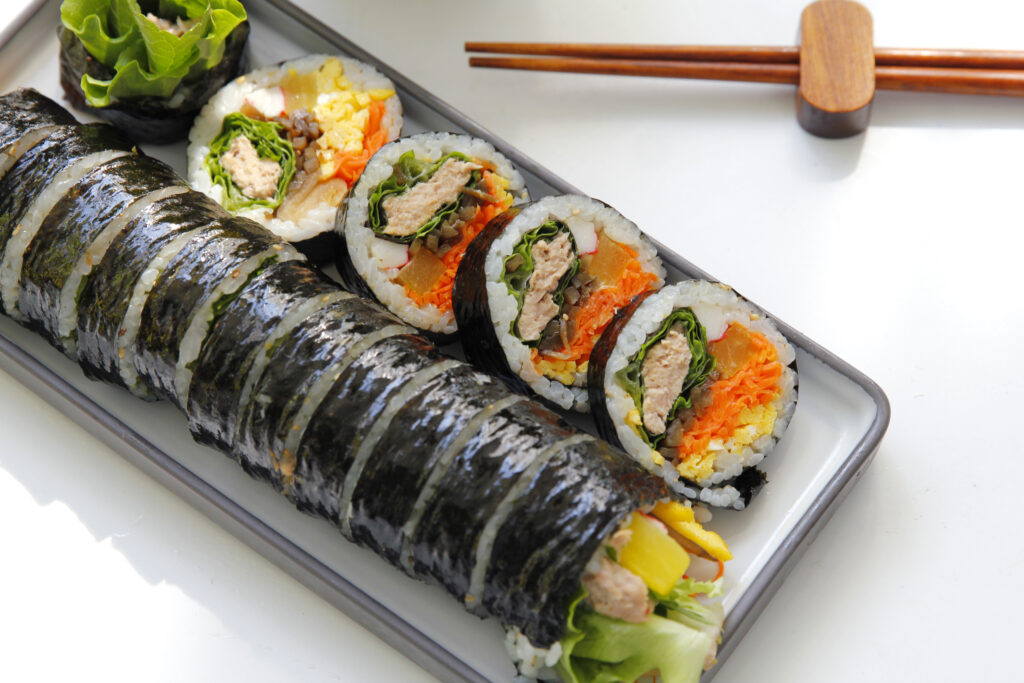
Gimbap Joseon Gimbap in Seoul : 68, Yulgok-ro 3-gil, Jongno-gu, Seoul (서울특별시 종로구 율곡로3길 68)
About Jeonju Bibimbap (전주 비빔밥)
-
Samgyetang (삼계탕) for summer #1 health in korea
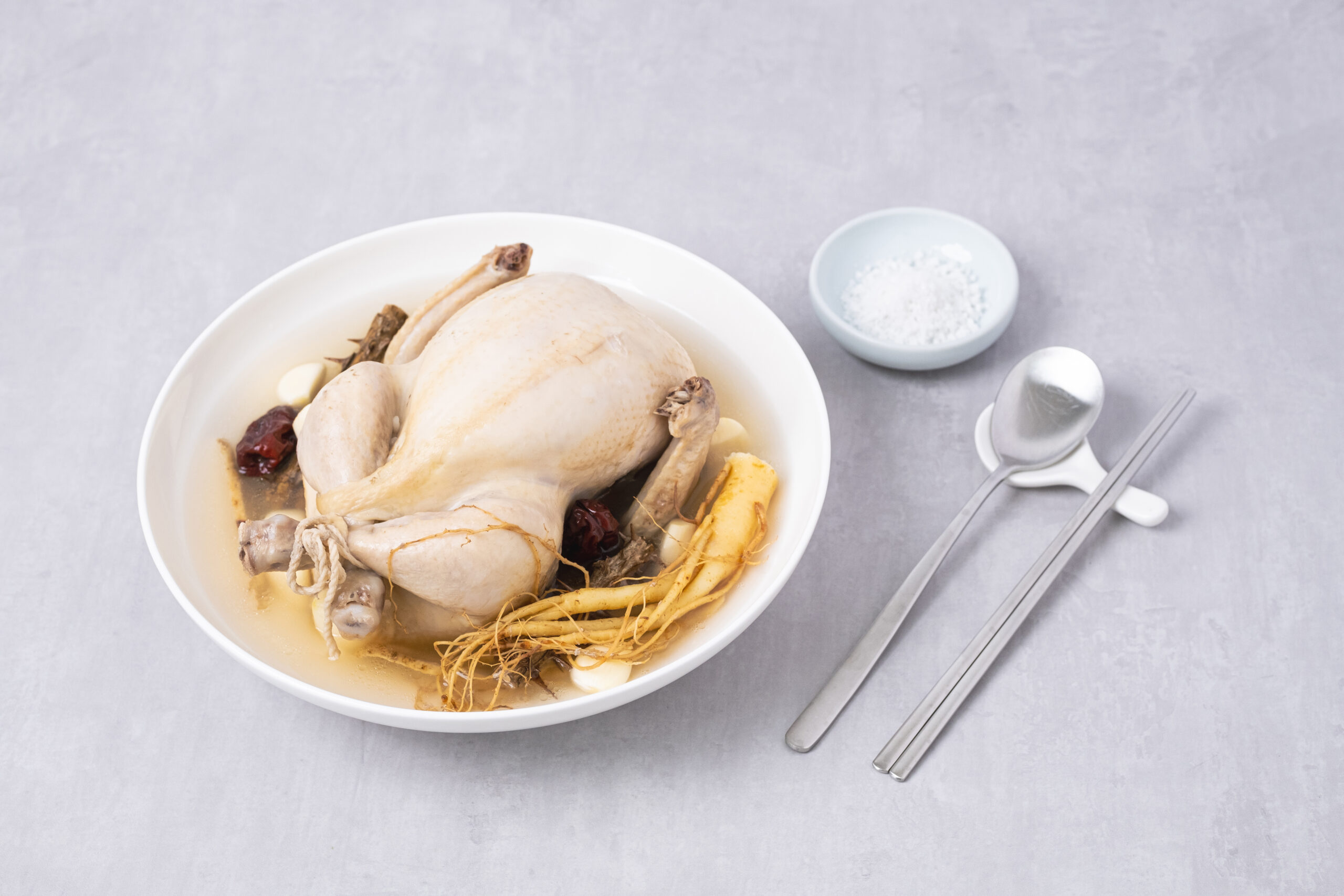
What is Samgyetang?
“Samgyetang” (삼계탕) is a Korean word that breaks down into three components:
- “Sam” (삼): This refers to “ginseng,” which is a widely used medicinal herb in traditional Korean medicine. Ginseng is known for its potential health benefits, including boosting energy and promoting overall well-being.
- “Gye” (계): This part of the word means “chicken” in Korean.
- “Tang” (탕): This translates to “soup” or “stew” in Korean.
So, when you put it all together, “Samgyetang” literally means “ginseng chicken soup” or “ginseng chicken stew.” The name reflects the dish’s main ingredients and its traditional association with providing nourishment and energy, especially during the hot summer months.

www.k-foodtrade.or.kr Cooking Method
Samgyetang (삼계탕) is a traditional Korean dish that consists of a whole young chicken stuffed with various ingredients and simmered in a rich, flavorful broth. It’s often considered a nourishing and revitalizing dish, especially popular during the hot summer months. The dish is believed to have restorative properties and is commonly enjoyed to boost energy and stamina.
Here’s a breakdown of the components and preparation of Samgyetang:
Ingredients:
- Young chicken (usually around 600-800 grams)
- Glutinous rice
- Korean ginseng (fresh or dried)
- Jujubes (Korean red dates)
- Garlic cloves
- Ginger slices
- Chestnuts
- Optional: pine nuts, ginkgo nuts, other medicinal herbs
Instructions:
- Preparing the Chicken:
- Clean and wash the chicken thoroughly.
- Remove excess fat and the giblets from the chicken’s cavity.
- Stuffing the Chicken:
- Rinse glutinous rice and soak it in water for about 30 minutes.
- Drain the rice and stuff the chicken’s cavity with the soaked rice, some ginseng, jujubes, garlic cloves, ginger slices, and other optional ingredients like chestnuts or nuts.
- Cooking the Dish:
- In a pot, add water and bring it to a boil.
- Place the stuffed chicken in the boiling water.
- Add more ginger slices, garlic cloves, and ginseng to the pot for extra flavor.
- Reduce the heat to a simmer and cook the chicken for about 1 to 1.5 hours, until the chicken is tender and the rice is cooked.
- Serving:
- Samgyetang is often served hot in the pot it was cooked in.
- Season the broth with salt and pepper according to your taste.
- The dish is usually accompanied by side dishes like kimchi, sliced scallions, and a dipping sauce made with salt and ground black pepper.
Samgyetang is considered a comfort food and is often consumed during the hottest days of summer in Korea as it’s believed to help cool down the body and provide essential nutrients. It’s also enjoyed year-round for its rich flavors and nutritional benefits.
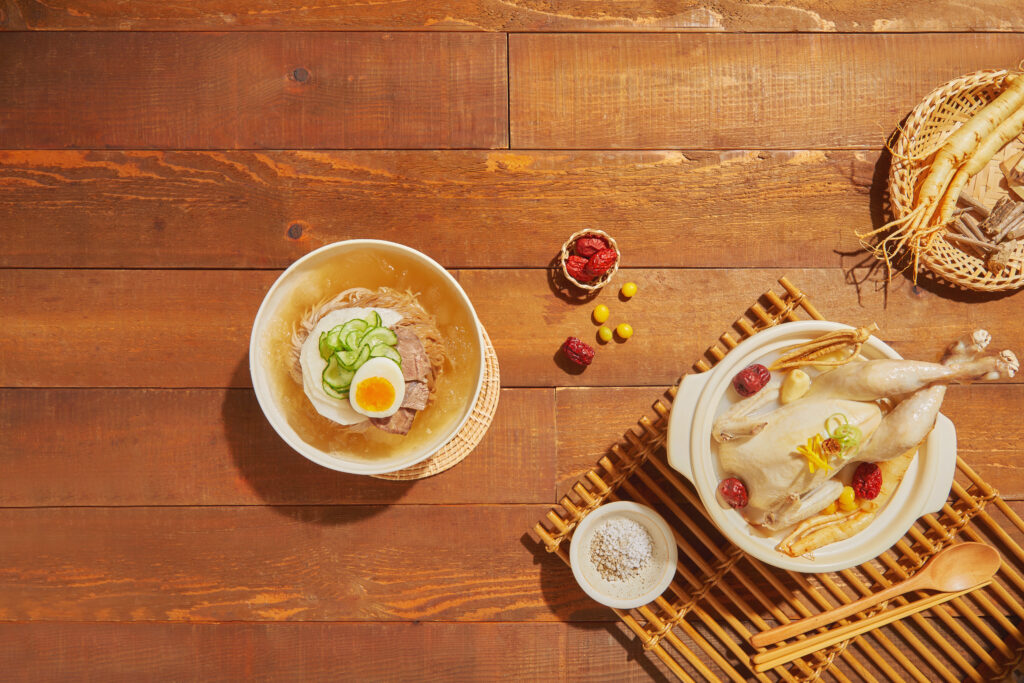
www.k-foodtrade.or.kr Famous Restaurant in Korea for Samgyetang?
address : 1,seosomunro 11gil, jung-gu, seoul, Korea
Recommend to Read
2023 Korean Andong Jjimdak Recipe
-
Japchae (잡채) is Korean Traditional Noodle 2023
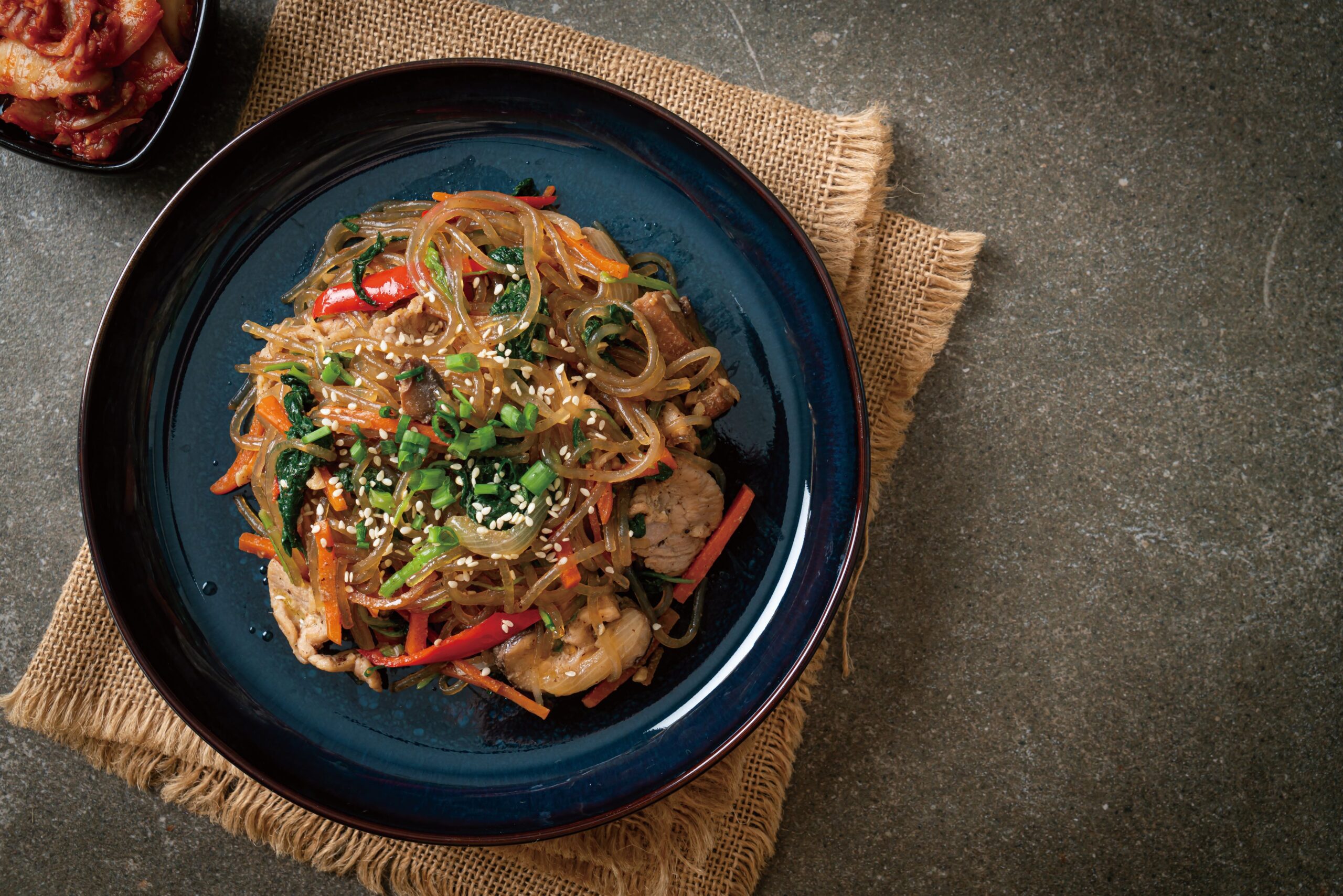
Japchae is Korean Traditional Food
Japchae is a popular Korean dish made with glass noodles made from sweet potato starch, various vegetables, meat (usually beef), and sometimes mushrooms, which is known for its vivid color, delicious taste, and unique texture. Japche is often served as a side dish (lunch box) or as a main course.
Ingredients of Japchae has variouse but common vegetables include carrots, spinach, bell peppers, onions, and mushrooms, which are typically sliced and set aside to maintain an individual texture and flavor. In addition, sesame and sometimes thinly sliced omelet strips may be added for decoration.
Japchae is a combination of sweet and salty, and is also loved for its combination of attractive noodles and soft crunchy vegetables.It is often eaten at celebrations, gatherings, and special occasions, but it is also common in Korean restaurants and home cooking.Cooking Method
Ingredients:
For the noodles:
- 200g sweet potato glass noodles (dangmyeon)
- Water for boiling
- 1 tablespoon sesame oil
For the vegetables and meat:
- 150g beef (ribeye or sirloin), thinly sliced
- 1 small carrot, julienned
- 1 small onion, thinly sliced
- 1 red bell pepper, thinly sliced
- 2 cups spinach, blanched and squeezed
- 5-6 shiitake mushrooms, soaked and sliced
- 2 cloves garlic, minced
- 2 tablespoons vegetable oil for cooking
- Salt and pepper to taste
For the seasoning:
- 3 tablespoons soy sauce
- 1 tablespoon sugar
- 1 tablespoon sesame oil
- 1 teaspoon toasted sesame seeds
Instructions:
- Cook the noodles:
- Boil the sweet potato glass noodles in water according to the package instructions until they are soft and translucent.
- Drain and rinse the noodles under cold water to stop the cooking process.
- Mix the noodles with 1 tablespoon of sesame oil to prevent sticking. Set aside.
- Prepare the vegetables and meat:
- Heat 1 tablespoon of vegetable oil in a pan over medium heat.
- Stir-fry the beef slices until they are fully cooked. Remove from the pan and set aside.
- In the same pan, add another tablespoon of vegetable oil.
- Sauté the garlic, onion, carrot, bell pepper, and mushrooms until they are tender and slightly caramelized.
- Add the cooked beef and blanched spinach to the pan. Season with salt and pepper. Stir well to combine.
- Mix the seasoning:
- In a small bowl, mix together the soy sauce, sugar, sesame oil, and toasted sesame seeds to create the seasoning sauce.
- Combine everything:
- Add the cooked glass noodles to the pan with the vegetables and meat.
- Pour the seasoning sauce over the mixture and stir-fry everything together until the noodles are evenly coated and heated through.
- Serve:
- Transfer the Japchae to a serving dish.
- Garnish with additional toasted sesame seeds and thinly sliced omelette strips if desired.
- Japchae can be served warm or at room temperature as a main dish or side dish.
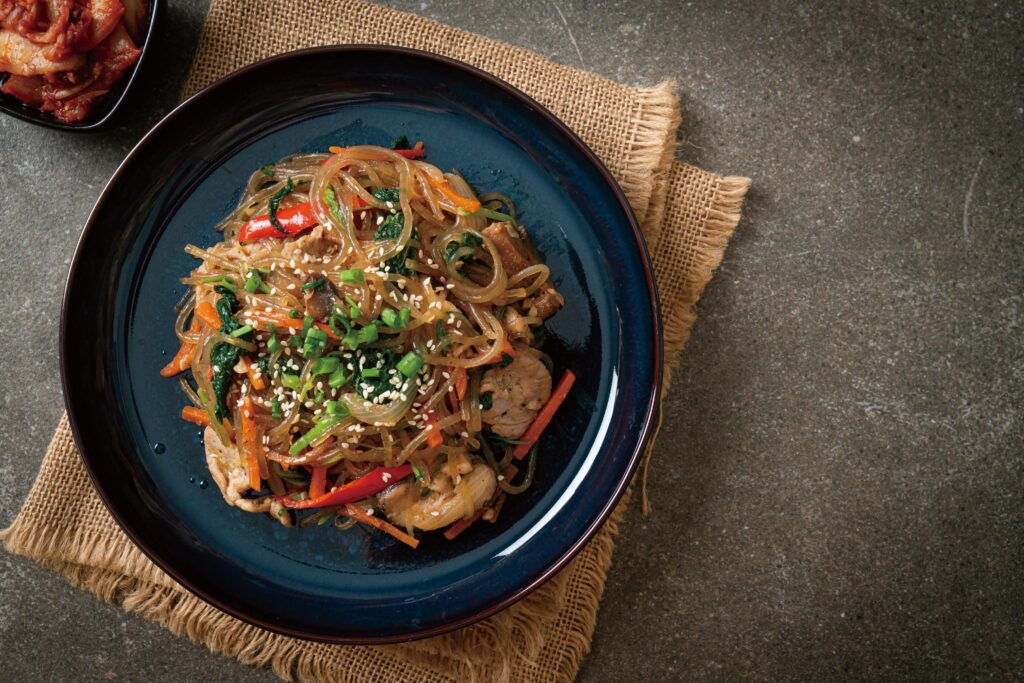
www.k-foodtrade.or.kr Japchae Myeongdong, Seoul
Place Name : Jinsa Daek Myeongdong(진사댁 명동)
Address : 30-1 Myeongdong-gil, jung-gu, Seoul, South Korea.

Learn about Samgyetang / image click -
Odeng, Welcome to Busan, Try to eat First.
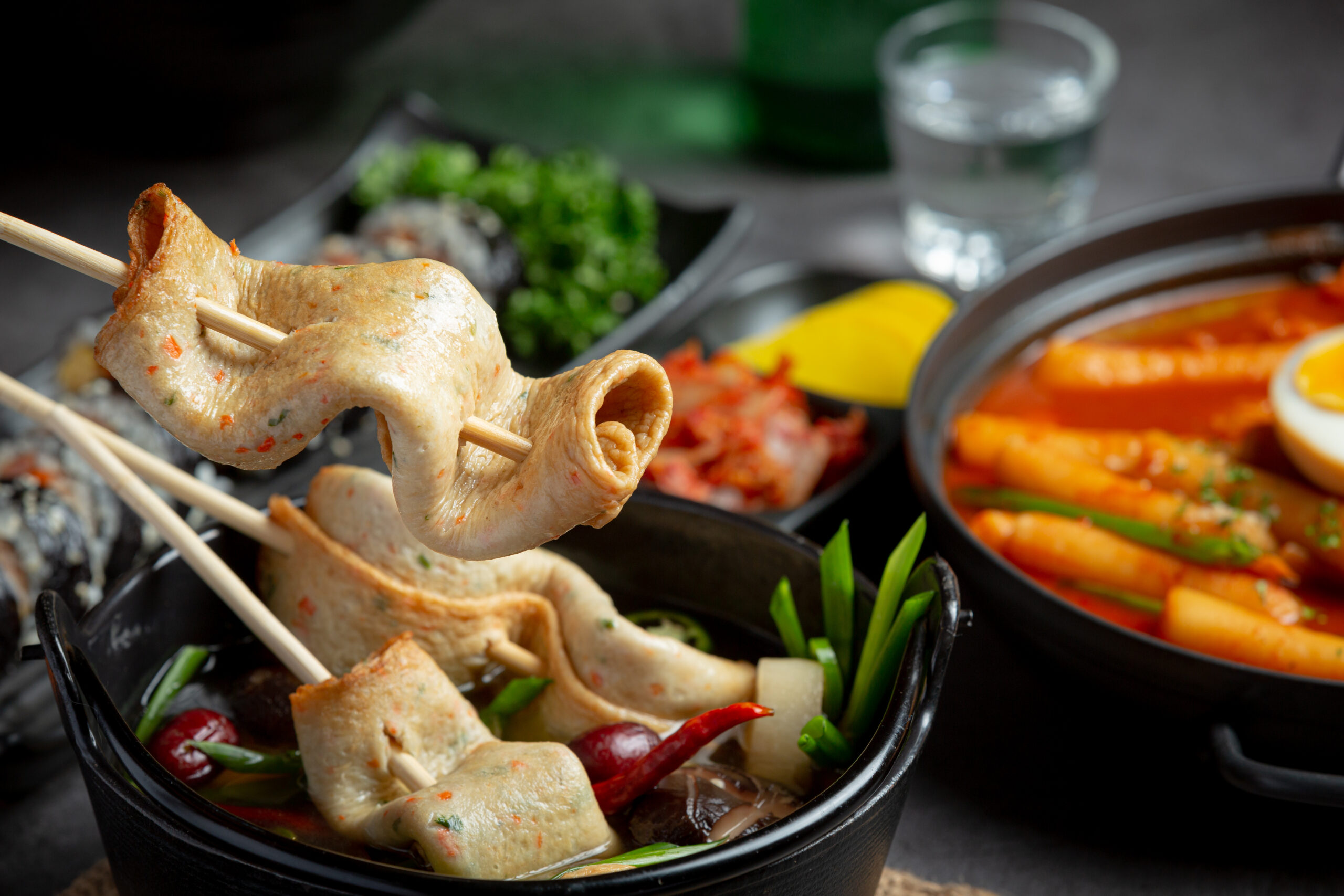
Odeng (오뎅), also known as eomuk (어묵), is a popular Korean street food that consists of skewered fish cakes that are typically boiled or steamed and served in a warm and savory broth. It is beloved by locals and visitors alike for its comforting taste and affordability. It’s a quintessential street food that can be found in various locations across Korea. Here’s more information about this famous Korean snack:
Ingredients and Preparation:
Ingredients and Preparation:
- Fish Cake: It is made from fish paste that is seasoned with various ingredients like starch, salt, and sometimes other flavorings. The fish paste is then shaped into various forms, such as cylinders, ovals, or even intricate designs.
- Skewering: The fish cakes are skewered onto wooden sticks or skewers, making them easy to eat and carry.
- Boiling or Steaming: The skewered fish cakes are then boiled or steamed until they are fully cooked. This process gives them a bouncy and slightly chewy texture.
Serving: It is typically served on the skewers in a warm and savory broth. The broth is often made from a base of anchovy and kelp stock, which infuses the fish cakes with additional flavor. The fish cakes absorb the flavors of the broth, creating a delicious and satisfying snack.
Dipping Sauce: It is often served with a dipping sauce, which is usually a mixture of soy sauce, sesame oil, and sometimes a touch of spicy gochugaru (red pepper flakes). Dipping the fish cakes in the sauce adds an extra layer of flavor and enhances the overall experience.
Variations and Availability:
- Tteokbokki Odeng: In some places, you can find odeng served with tteokbokki sauce, which is a spicy and sweet red pepper sauce often associated with another popular Korean street food, tteokbokki (spicy rice cakes).
- Eomuk Bokkeum: Eomuk bokkeum is a stir-fried version of fish cakes that are cooked with vegetables and a flavorful sauce. It’s a popular side dish often enjoyed with rice.
Cultural Significance: It holds cultural significance in Korea as a nostalgic and comforting street food that’s been enjoyed for generations. It’s often associated with cold weather and served as a warm and satisfying snack to ward off the chill.
Availability: It can be found at street food stalls, markets, and even in convenience stores throughout Korea. It’s a popular snack that’s enjoyed by people of all ages and backgrounds.
Odeng as a Symbol: Odeng’s affordability, accessibility, and heartwarming qualities have turned it into a cultural symbol of Korean street food culture, representing the simple joys of snacking and communal eating in Korea.
Famous place for Odeng in Busan
- Jagalchi Fish Market (자갈치시장): As Busan’s most famous fish market, Jagalchi Market is a prime destination to try fresh seafood, including odeng. You’ll find numerous vendors offering a variety of fish cake skewers. The market is also a cultural experience as you can see a wide range of seafood on display.
- Bupyeong Kkangtong Market (부평깡통시장): This traditional market is known for its vibrant atmosphere and diverse food offerings. You’ll find a variety of food stalls selling odeng and other street foods.
- Gukje Market (국제시장): Gukje Market is one of the largest markets in Busan, offering an array of goods and foods. You can explore the market’s alleys and find stalls selling odeng, along with other local treats.
- Haeundae Beach Area: Near Haeundae Beach, especially during the summer months, you might find street vendors selling odeng along the beach promenade. It’s a great opportunity to enjoy the sea breeze and delicious street food.
- Seomyeon Food Street: Seomyeon is a bustling commercial district in Busan with a variety of restaurants and street food stalls. You’re likely to come across odeng vendors in this area.
- Busan Station Area: The area around Busan Station is another spot where you might find odeng stalls, especially catering to commuters and travelers.
- Taejongdae Park: If you’re visiting Taejongdae Park, a scenic coastal park in Busan, you might find odeng stalls near the entrance or within the park.
Remember that Busan’s street food scene is lively and dynamic, so you might discover odeng stalls in unexpected places as well. Don’t hesitate to explore different areas of the city and try this popular Korean street food.
Recommend Cooking Method with Odeng
“Odeng” (어묵) is a popular Korean street food made from fish cake skewers that are typically served in a warm and savory broth. Fish cake skewers are commonly enjoyed by Koreans as a quick and satisfying snack. Here’s how odeng is typically prepared and cooked:
Ingredients:
- Fish cake skewers (odeng)
- Broth or soup base (often made from dashi or anchovy stock)
- Soy sauce
- Sugar
- Mirin (rice wine for cooking)
- Optional toppings (such as green onions, sesame seeds, or sesame oil)
Cooking Method:
- Prepare the Broth:
- In a pot, prepare a broth or soup base. This can be made using dashi (Japanese stock) or anchovy stock. The broth provides the flavorful base for cooking and serving the odeng skewers.
- Season the Broth:
- Season the broth with soy sauce, sugar, and mirin to achieve a savory-sweet flavor profile. The exact quantities of these ingredients can be adjusted to taste.
- Simmer the Broth:
- Heat the seasoned broth on the stovetop and bring it to a gentle simmer. This will allow the flavors to meld together.
- Add the Odeng Skewers:
- Place the fish cake skewers (odeng) into the simmering broth. The skewers are typically made from processed fish cake mixture that has been molded onto sticks.
- Cooking and Absorption:
- Allow the odeng skewers to simmer in the broth until they are heated through and have absorbed some of the flavors from the broth.
- Serving:
- Once the odeng skewers are heated and have absorbed the flavors, they are ready to be served. They are often served directly from the pot of broth, allowing the skewers to stay warm.
- Optional Toppings:
- Odeng can be enjoyed with optional toppings such as chopped green onions, sesame seeds, and a drizzle of sesame oil. These toppings enhance the flavor and presentation of the dish.
- Sipping the Broth:
- The warm and savory broth in which the odeng is cooked is also an integral part of the experience. It’s common to sip the broth between bites of the fish cake skewers for a comforting and flavorful treat.
Odeng is a popular street food that can be found at various food stalls, markets, and convenience stores in South Korea. The cooking method described above showcases the traditional way of preparing and serving odeng, offering a tasty and comforting snack for people on the go.
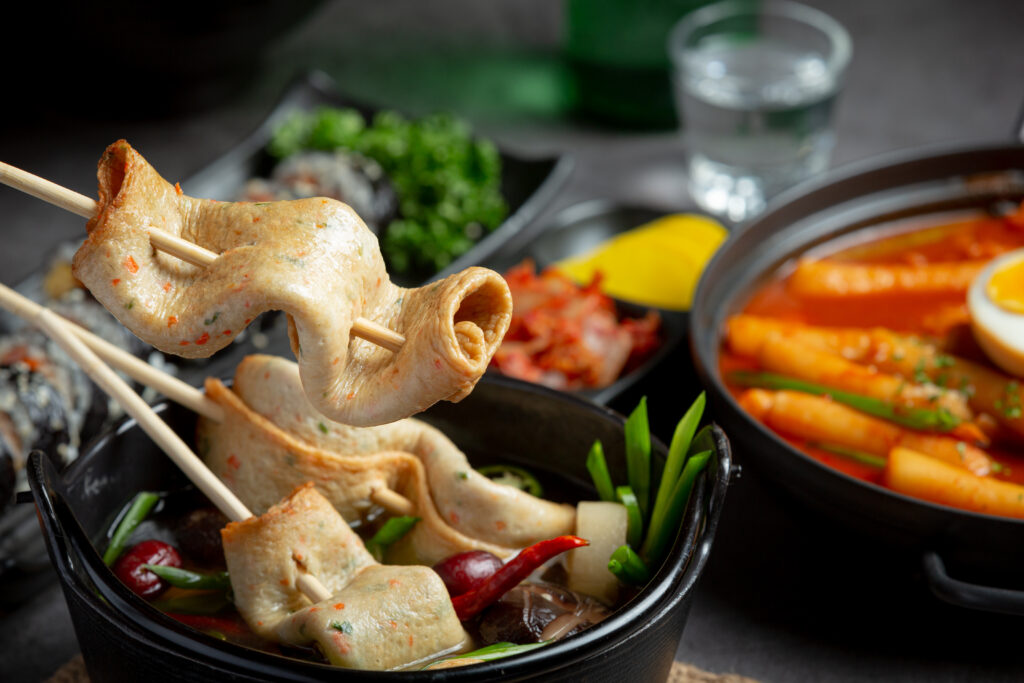
Korean fish cake and vegetable soup on table …
…
…
Recommend to read >>>
Samgyetang(삼계탕) for summer #1 health in korea
-
Hotteok (호떡) is a sweet and reliable street food in Korea 2023 Aug

Hotteok (호떡) is a popular and beloved Korean street food and snack. It’s a type of sweet pancake that’s typically filled with a mixture of brown sugar, cinnamon, and chopped nuts. Hotteok is known for its crispy exterior and gooey, sweet filling, making it a delightful treat, especially during the colder months. Here’s more information about Hotteok:
History
Hotteok (호떡) is a popular Korean street food and snack that consists of sweet pancakes filled with a mixture of sugar, cinnamon, and chopped nuts. The history of hotteok dates back many years and is closely tied to Korea’s culinary traditions. Here’s a brief overview of the history of hotteok:
Historical Origins: The exact origins of hotteok are not well-documented, but it is believed that the dish has a long history in Korea. Hotteok’s sweet and doughy nature made it a favorite treat for Koreans, and it likely evolved over time based on the available ingredients and culinary influences.
Traditional Ingredients and Preparation: Traditional hotteok is made by kneading wheat flour dough, filling it with a mixture of sugar, cinnamon, and chopped nuts (such as peanuts or seeds), and then pan-frying until golden and crispy. The filling becomes gooey and flavorful when cooked, creating a satisfying contrast with the outer dough.
Seasonal Significance: Hotteok has been associated with various holidays and occasions in Korea. For example, it was traditionally enjoyed during winter as a warming treat. The rich and sweet nature of hotteok makes it particularly appealing in colder months.
Street Food Culture: Over the years, hotteok has become a popular street food in Korea. Vendors set up stalls or carts in busy areas, where they prepare hotteok fresh for customers. The enticing aroma of cooking hotteok and the sight of its golden exterior attract locals and tourists alike.
Modern Variations: While traditional hotteok remains popular, there are now various modern variations available. Some include different fillings like cheese, chocolate, red bean paste, and even savory options. These adaptations cater to changing tastes and preferences.
Cultural Significance: Hotteok holds cultural significance beyond its culinary appeal. It represents comfort, nostalgia, and the joy of enjoying simple pleasures. It’s a favorite among people of all ages and is often associated with childhood memories and special moments.
Influence on Pop Culture: Hotteok’s popularity has extended to pop culture as well. It has been featured in Korean dramas, variety shows, and even K-pop songs, contributing to its status as an iconic Korean snack.
In summary, hotteok’s history is deeply rooted in Korean culinary heritage, and it has evolved over time to become a beloved street food enjoyed by generations. Its delicious flavors, gooey texture, and cultural significance have secured its place as a cherished treat in Korea’s culinary landscape.
How to make Hotteok?
Ingredients:
- Dough: The dough for Hotteok is made with a mixture of flour, water, yeast, sugar, and a pinch of salt. It’s similar to regular pancake batter but slightly thicker.
- Filling: The classic filling consists of a mixture of brown sugar, cinnamon, and chopped nuts. Common nuts used include peanuts, walnuts, or sunflower seeds.
Preparation and Cooking:
- Making the Dough: The dough is prepared by mixing the ingredients together and allowing the dough to rise for a certain period, usually around 30 minutes to an hour.
- Preparing the Filling: The filling mixture is made by combining brown sugar, ground cinnamon, and chopped nuts. The sugar and cinnamon create a deliciously fragrant and sweet-spicy flavor, while the nuts add a satisfying crunch.
- Assembling the Pancakes: Small portions of the dough are flattened into circles, and a spoonful of the filling mixture is placed in the center. The edges of the dough are then sealed, enclosing the filling.
- Cooking: The filled dough is flattened and pressed into a disc shape, then pan-fried on a griddle or skillet until both sides are golden brown and crispy. As the sugar in the filling melts, it caramelizes, creating a gooey and sweet interior.
Serving: Hotteok is typically served hot off the griddle. It’s often enjoyed on the go as a street food, especially in outdoor markets or near schools. The contrast between the crispy exterior and the warm, gooey filling is a big part of what makes Hotteok so appealing.
Variations: While the classic brown sugar, cinnamon, and nut filling is the most common, there are also variations of Hotteok that offer different fillings, such as chocolate, cream cheese, sweet potato, or even savory options like kimchi and cheese.
Availability: Hotteok is especially popular during the winter months when the warm and comforting snack provides a delightful respite from the cold weather.
If you have the chance to try Hotteok, I highly recommend it! It’s a wonderful example of Korean street food that captures the balance between sweet and savory flavors, as well as different textures.
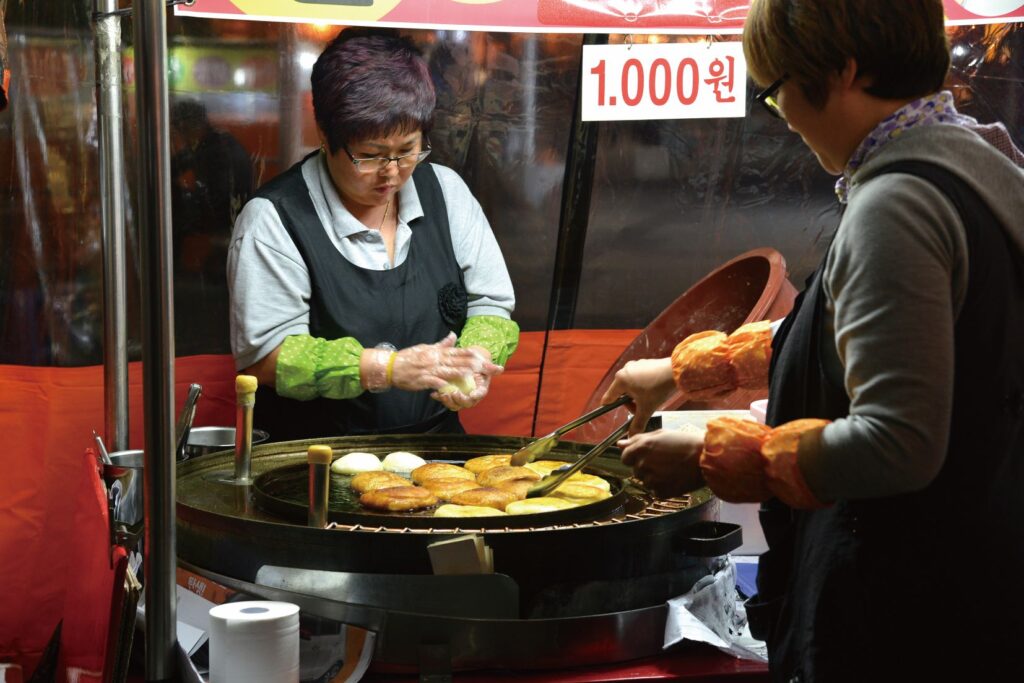
www.k-foodtrade.or.kr 
www.k-foodtrade.or.kr Famous Place in Korea : SAMCHEONGDONG Hottoek
Address : 82-6, Yulgok-ro 3-gil, Jongno-gu, Seoul 03061 South Korea
Recommend to Read >> Jjajangmyeon, Korean Black Noodle Aug, 2023.
